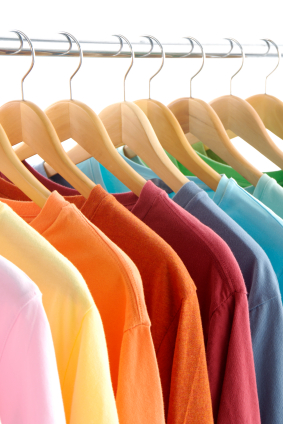Coming Into The Closet:
How to Strategize, Sort and Store Your Wardrobe
Part Two of a Two-Part Series
Smart Storage Tips
In my last newsletter, I shared with you how to create a look you love by strategizing and sorting your wardrobe. All this is gleaned from the international best-selling book, “the life-changing magic of tidying up: the Japanese art of decluttering and organizing” by Marie Kondo.
In this newsletter, Part Two of a two-part series, we’ll share how to store and organize your “new” wardrobe. Once you’ve completed the wardrobe sorting process, you’ll be amazed to find that you have only one-third to one-quarter of the clothes you began with! What a feeling of freedom that should bring.
Now that you’ve pared down your wardrobe to include only those items you love, it’s time to determine where, and how, to store them. Most of my clients prefer storing their clothing on hangers. Items such as coats, suits, jackets, skirts and dresses are actually best stored on hangers. And hanging these items is not only easier to do, it makes them easier to find in your closet.

Hang Out with Your Wardrobe…or Not?
However, Kondo finds that folding clothing is preferable to hanging for several reasons. First, you can fit 20 to 40 folded pieces of clothing in the same amount of storage space required to hang 10 pieces. The real benefit, however, is that as you fold each piece of clothing, you must handle it. This pours your personal energy into it.
As you touch each piece, you show your appreciation for it. In the Japanese language, the literal meaning of the phrase “to apply hands” is te-ate, which ls the word for healing. Just as a gentle massage seems to heal body and soul, the same is true for clothing.
Kondo believes that folding your clothing is an act of love and appreciation for the way it supports your lifestyle. Therefore, when you fold rather than hang your garments, be certain to put your heart into it and thank them for protecting you from the elements.

Know When to Fold ‘Em
The best way to fold garments is so that they will stand up vertically. Most of us are used to seeing clothing stacked horizontally, one garment on top of another. But stacking items not only causes more wrinkles, you have to rummage through the stack to find what you’re looking for.
The goal is to fold each piece of clothing into a simple, smooth rectangle. First, fold each lengthwise side of the garment toward the center, then tuck the sleeves in to make a long rectangular shape. Next pick up one short end of the rectangle, and fold it toward the other short end. Keep folding in that manner until the garment, when lying on its side, is almost as deep as the drawer. Because many different pieces will be displayed in this manner, it makes it easier to find the items needed.

Organizing Your Closet
Next is the secret to energizing and arranging your closet: The most basic rule is to hang clothes in the same category side by side, dividing your closet into separate sections for such items as pants, tops, jackets and suits.

This Way Please
To prevent your closet from becoming messy again, arrange clothes so that they “rise to the right. Do this by simply imagining an arrow rising to the right. According to feng shui, the Japanese art of placement, as your eye travels from left to right you feel lighter and more comfortable because the energy flows upward.
This means that you hang heavy items on the far left side of your closet and increasingly lighter items on the right. Heavy items include those with length, those made from heavy material and those that are dark in color. So as you move toward the right side of the closet, the length of your clothing will grow shorter, the material thinner and the color lighter.
“By category, coats would be on the far left, followed by dresses, jackets, pants, skirts and blouses,” notes Kondo. Also organize clothes in each category from heavy to light and within the same color palette. All black tops should be placed together, for instance, just as all brown pants should be placed together.
As to seasonal clothing, try not to “change closets” each Summer and Winter. If you can, organize all seasons of your clothing together in the same manner explained, with heavier fabrics on the left in each category. For instance, you can place summer-weight black trousers and winter-weight black trousers together. Simply hang the winter-weight pieces to the left of the summer wardrobe pieces. Winter coats can be placed in the back of the closet in the off-season.

In a New Year’s Nutshell
Kondo’s book holds much more information on how to organize your life, whether it concerns clothing, books or keepsakes. But I think her information on organizing your closet is quite provocative. As in the practice of feng shui, the professional organizer gives clothing the same respect that she gives all energy flow, in the home or in the world–energy that transfers to you–making your newly organized closet a joy in the New Year. Cheers!



